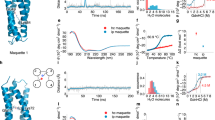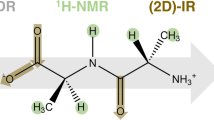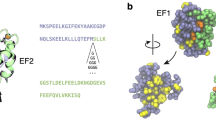Abstract
Protein engineering is a means of probing the role of electrostatic interactions in protein functions; this elegant technique has been applied to the elucidation of electrostatic effects in enzyme catalysis1. Here we show how the use of mutant proteins allows the determination of the contributions of individual charges to the free energy of ion binding to proteins. We have investigated the importance of three negatively charged side chains in the binding of Ca2+ to bovine calbindin D9K (ref. 2): these are clustered around the calcium sites but are not directly involved as ligands. Each of these charges is found to contribute ˜7 kJ mol–1 to the free energy of binding of two Ca2+ ions and to affect the cooperativity of Ca2+ binding. The influence of surface charges on ion binding to proteins may be more common than generally supposed and could have important consequences for protein function.
This is a preview of subscription content, access via your institution
Access options
Subscribe to this journal
Receive 51 print issues and online access
$199.00 per year
only $3.90 per issue
Buy this article
- Purchase on Springer Link
- Instant access to full article PDF
Prices may be subject to local taxes which are calculated during checkout
Similar content being viewed by others
References
Thomas, P. G., Russell, A. J. & Fersht, A. R. Nature 318, 375–376 (1985).
Wasserman, R. H. & Fullmer, C. S. in Calcium and Cell Function Vol. 2 (ed. Cheung, W. Y.) 175–216 (Academic, New York, 1982).
Kretsinger, R. H. & Nockolds, C. E. J. biol. Chem. 248, 3313–3326 (1973).
Szebenyi, D. M. E. & Moffat, J. J. biol. Chem. 261, 8761–8777 (1986).
Brodin, P. et al. Biochemistry 25, 5371–5377 (1986).
Linse, S. et al. Biochemistry 26, 6723–6735 (1987).
Dalgarno, D. C., Levine, B. A., Williams, R. J. P., Fullmer, C. S. & Wasserman, R. Eur. J. Biochem. 137, 523–529 (1983).
Levine, B. A. & Williams, R. J. P. in Calcium and Cell Function Vol. 2 (ed. Cheung, W. Y.) 1–38 (Academic, New York, 1982).
Kretsinger, R. H., Mann, J. E. & Simmons, J. G. in Proceedings of the Fifth Workshop on Vitamin D (ed. Norman, A. W.) 233–248 (De Gruyter, New York, 1982).
Waiters, J. R. F. in Calcium-Binding Proteins in Health and Disease (ed. Norman, A. W. et al.) 122–124 (Academic, New York, 1987).
Tsien, R. Biochemistry 19, 2396–2404 (1980).
Author information
Authors and Affiliations
Rights and permissions
About this article
Cite this article
Linse, S., Brodin, P., Johansson, C. et al. The role of protein surface charges in ion binding. Nature 335, 651–652 (1988). https://doi.org/10.1038/335651a0
Received:
Accepted:
Issue Date:
DOI: https://doi.org/10.1038/335651a0
This article is cited by
-
Large-scale identification of human protein function using topological features of interaction network
Scientific Reports (2016)
-
Calcium binding, structural stability and guanylate cyclase activation in GCAP1 variants associated with human cone dystrophy
Cellular and Molecular Life Sciences (2010)
-
Statistical analysis of structural characteristics of protein Ca2+-binding sites
JBIC Journal of Biological Inorganic Chemistry (2008)
-
Reductive methylation andpKa determination of the lysine side chains in calbindin D9k
Journal of Protein Chemistry (1994)
-
Models of the three-dimensional structures of echidna, horse, and pigeon lysozymes: Calcium-binding lysozymes and their relationship with α-lactalbumins
Journal of Protein Chemistry (1994)
Comments
By submitting a comment you agree to abide by our Terms and Community Guidelines. If you find something abusive or that does not comply with our terms or guidelines please flag it as inappropriate.



